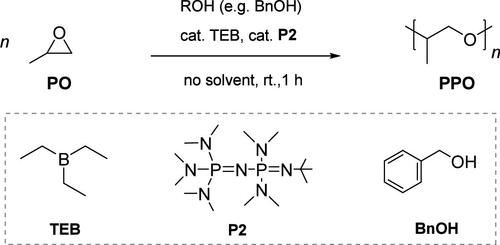氧化丙烯的无金属开环聚合:本科生有机化学实验室中聚醚的合成与表征
IF 2.5
3区 教育学
Q2 CHEMISTRY, MULTIDISCIPLINARY
引用次数: 0
摘要
环氧丙烷(PO)的开环聚合(ROP)是聚合物合成的一个基本反应。聚环氧丙烷(PPO)产品广泛用于制造泡沫和弹性体。近年来,有机催化聚合方法的创新大大提高了这种聚合反应的效率和可控性。本文介绍了学生利用三乙基硼和磷苯碱作为二元有机催化剂体系,通过 PO 的 ROP 合成 PPO 的实验室实验。学生还利用核磁共振光谱和凝胶渗透色谱法对单体转化率、聚合物结构和聚合物分子量进行了表征。该实验旨在纳入本科二年级有机化学实验课程。该实验在室温下进行,不含溶剂,在 3 小时内完成,便于本科二年级学生操作。该实验还向学生介绍了有机化学和高分子化学的几个基本概念。本文章由计算机程序翻译,如有差异,请以英文原文为准。

Metal-Free Ring-Opening Polymerization of Propylene Oxide: Synthesis and Characterization of Polyether in the Undergraduate Organic Chemistry Laboratory
Ring-opening polymerization (ROP) of propylene oxide (PO) is an essential reaction for polymer synthesis. The product of poly(propylene oxide) (PPO) is widely used for the manufacture of foams and elastomers. The recent innovation of organocatalytic polymerization methods has greatly improved the efficiency and controllability of this polymerization. This article describes the laboratory experiment where students synthesize PPO by the ROP of PO using triethylboron combined with a phosphazene base as a binary organocatalyst system. Students also use NMR spectroscopy and gel-permeation chromatography for the characterization of monomer conversion, polymer structure, and polymer molecular weight. The laboratory experiment is sought to be incorporated into the second-year undergraduate organic chemistry laboratory curriculum. The experiment is performed at room temperature, is solvent-free, and is completed within 3 h, which is easy for second-year undergraduate students to operate. The experiment also introduces students to several fundamental concepts of organic chemistry and polymer chemistry.
求助全文
通过发布文献求助,成功后即可免费获取论文全文。
去求助
来源期刊

Journal of Chemical Education
化学-化学综合
CiteScore
5.60
自引率
50.00%
发文量
465
审稿时长
6.5 months
期刊介绍:
The Journal of Chemical Education is the official journal of the Division of Chemical Education of the American Chemical Society, co-published with the American Chemical Society Publications Division. Launched in 1924, the Journal of Chemical Education is the world’s premier chemical education journal. The Journal publishes peer-reviewed articles and related information as a resource to those in the field of chemical education and to those institutions that serve them. JCE typically addresses chemical content, activities, laboratory experiments, instructional methods, and pedagogies. The Journal serves as a means of communication among people across the world who are interested in the teaching and learning of chemistry. This includes instructors of chemistry from middle school through graduate school, professional staff who support these teaching activities, as well as some scientists in commerce, industry, and government.
 求助内容:
求助内容: 应助结果提醒方式:
应助结果提醒方式:


